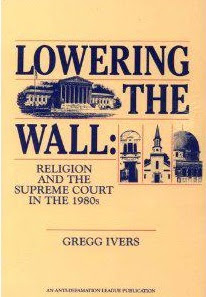Publisher: The Anti-Defamation League
Release: 1999
Genre: Political Opinion
With Lowering the Wall, Ivers has guided us through the disturbing evolution of the U.S. Supreme Court's standing on two of the most important concepts expressed in the Constitution: the freedom of religion and worship, and the separation of church and state. He repeatedly expresses his concern that during the 1980's, the Supreme Court began to noticeably depart from these vital constitutional values.
One point that was consistently stressed by Ivers, was the rise of religious fundamentalism, or the rigid adherence to a religion in American society. This rise in zealous activism occurred mainly under the presidency of Ronald Reagan. Indeed, many fundamentalists received the backing of the Reagan Administration in various pursuits to undermine the concept of the separation between church and state. A couple of these shifty endeavors included reintroducing prayer to public schools, and influencing the content of school curricula and textbooks. These rigid fundamentalists also sought to benefit from government support (i.e. monetary endorsement) in a plethora of ways, including religious displays at the public's expense. At the same time this was occurring, intolerance toward less mainstream religious practices grew. As one could reasonably infer, Ivers' feelings toward these happenings are in no way supportive.
Probably one of the more important aspects of Lowering the Wall was Ivers' analysis of the relationship between majoritarian religions and the court, particularly the Rehnquist Court. Indeed, the author brings attention to the indisputable fact that a certain deference has been shown toward mainstream religious practices. Sadly, this respect and acknowledgement has not been extended to many unorthodox or minority religions. Minority groups, such as Native Americans, Black Muslims and Jews were all "overlooked" by the current court of the 1980s, which intended to minimize the importance of their personal religious beliefs while grossly over-promoting the importance of counteractive government interests. The rise in mainstream religious fundamentalism was obviously highly suppressive toward those of the non-mainstream variety, and Ivers is only too quick to point this out.
In Lowering the Wall, Gregg Ivers places obvious emphasis on the biased nature of the courts in the 1980s. This political issue may be of no interest to some, but I find it a highly important matter, even today. Some may shrug this book off as a good example of liberal "nonsense," but I would dispute that claim. Ivers obviously favors the adherence of original intent, and who but the most staunchy of corrupt politicians could favor otherwise? At the time Lowering the Wall was published, Gregg Ivers was the Assistant Professor of Government at American University, and I am sure anyone who shrugs off his credentials is more than a little ignorant. This author provided highly legitimate sources to back his claims: direct accounts of the court cases concerning the scope of what his book covers. It is my hope that this author's writings continue to be read by interested individuals and persist long into the future.
Readers should approach this book hesitantly. Although dry, it is strongly opinionated. Ivers is very straightforward with where his allegiance lies when it comes to the political battlefield. The way Ivers explains the reasoning behind the turmoil of the 80s largely places Republicans at fault. In this case, I don't know If I could blame him. It is of my opinion that all religious beliefs and practices are equal, or in fact, one and the same. Different names have similar meanings, and diverse practices have origins akin. By law, in the United States, government is to give no preferential treatment to one religion over another. Religion cannot be endorsed, nor can it be condemned. I believe this entire system was based on balance, of which our founding fathers were the prime constructors. Irreverence or a failure to adhere to this concept can only lead to more turmoil, and disrupt the already precarious relationship between government and the people. I urge and implore the people of our nation to open their minds, to see the broader outlook. This is vitally important if we are to remain unified and stoic in the coming times.
Overall, Lowering the Wall is an excellent read for those whose hearts are set on politics. I found it interesting myself, but than again I am a bit of political speculator. Gregg Ivers is truly an intelligent individual, capable of expressing his opinions in a subtle, yet lustrous manner. Readers should strive to understand the connections Ivers frequently demonstrates, and understand the points he makes about the referenced court cases. All in all, I discovered this book to be well-rounded and quietly powerful.
Ivers, Gregg. (1991) Lowering the Wall: Religion and the Supreme Court in the 1980s. United States: Anti-Defamation League
